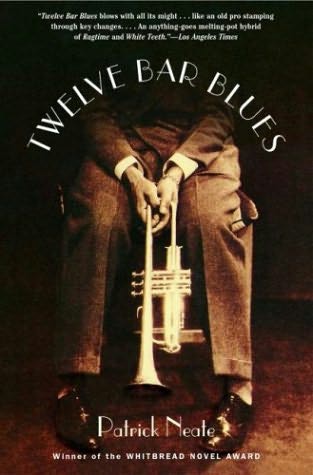
“‘The ancestors teach us that destiny is both the solace of the strong and the refuge of the weak.’
Tongo tutted. ‘I know that!’
‘But they also teach us,’ Musa continued, improvising desperately, ‘that destiny is sometimes no more than your penis in disguise.’”
And so it is with Twelve Bar Blues, which interweaves a multi-generational story of family, fate, and jass. The book is structured in two parts, polyphony and dissonance, each containing twelve bars (chapters) in the simplest blues form: I-I-I-I-IV-IV-I-I-V-V-I-I. The story is bookended with a prelude, because some stories are forgotten, and a coda, because some stories are never told.
So there’s Lick Holden, (I) perhaps the finest horn player that ever lived. Lick’s story is of Cooltown, Louisiana in the time just after emancipation, of Toothless Bessie’s tonk, of jamming with and influencing young Louis “Dipper” Armstrong, and of using his horn to find his long lost beauty of a sister, Sylvie (who wasn’t of no blood relation).
So there’s Chief Tongo and his village’s zakulu Musa (IV), smoking gar in their Zimbawian village in 1998, being intruded upon by Bunmi Dorowoju (aka Coretta Pink), Professor of Ethnoarcheology at Northwestern University, who has found an ancient headdress worn by the love of Zike - who had the voice of an angel – just before Zike was taken by the magic of Musa’s jealous zakulu ancestor to be a slave in America. Near Cooltown, Louisiana, where he had children.
So there’s Jim and Sylvia (V), named so for her grandmother, meeting on an airplane from London to New York, but ultimately trying to find out of Sylvia’s family history. Jim a lost soul and Sylvia a prostitute (retired) and a singer (part-time). But where did Sylvia’s blackness come from?
And through a tale so controlled by the twists of destiny and fate, all characters come to be connected. And through Neate’s lyrical and soulful writing style, you start to feel connected to all of the characters, too.
I’d say that reading this book reinvigorated my interest in playing the blues. I’d also say that reading this book reinvigorated my feelings about the sweetness of human spirit. Even though Neate is British writing about a distinctly American subject matter, even though some stories that are forgotten and some stories that are never told are those with the worst endings, and even though Lick Holden hasn’t yet figured out how to play the cornet with all four parts of his body when he first takes the stage at Toothless Bessie’s and rings out one note for 8 whole bars as loud and as crisp as any cornet player ever could and brings the somber and quiet crowd jubilantly to their feet, well, you just want to get up and whoop, too. For sho’.













